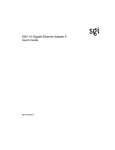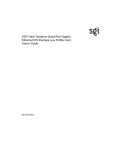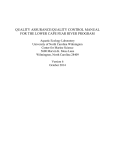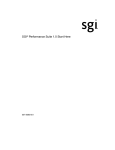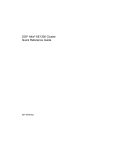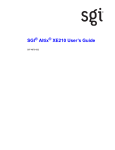Download SGI Ethernet Card User`s guide
Transcript
SGI® Altix® Systems Dual-Port Gigabit Ethernet PCI Express Board User’s Guide 007-5472-001 COPYRIGHT © 2008, Silicon Graphics, Inc. All rights reserved; provided portions may be copyright in third parties, as indicated elsewhere herein. No permission is granted to copy, distribute, or create derivative works from the contents of this electronic documentation in any manner, in whole or in part, without the prior written permission of Silicon Graphics, Inc. LIMITED RIGHTS LEGEND The software described in this document is “commercial computer software” provided with restricted rights (except as to included open/free source) as specified in the FAR 52.227-19 and/or the DFAR 227.7202, or successive sections. Use beyond license provisions is a violation of worldwide intellectual property laws, treaties and conventions. This document is provided with limited rights as defined in 52.227-14. TRADEMARKS AND ATTRIBUTIONS Silicon Graphics, SGI, the SGI logo, and Altix are registered trademarks, and SGI ProPack is a trademark of Silicon Graphics, Inc., in the United States and/or other countries worldwide. All other trademarks mentioned herein are the property of their respective owners. FCC WARNING This equipment has been tested and found compliant with the limits for a Class A digital device, pursuant to Part 15 of the FCC rules. These limits are designed to provide reasonable protection against harmful interference when the equipment is operated in a commercial environment. This equipment generates, uses, and can radiate radio frequency energy and if not installed and used in accordance with the instruction manual, may cause harmful interference to radio communications. Operation of this equipment in a residential area is likely to cause harmful interference, in which case the user will be required to correct the interference at personal expense. ATTENTION This product requires the use of external shielded cables in order to maintain compliance pursuant to Part 15 of the FCC Rules. VDE 0871/6.78 This equipment has been tested to and is in compliance with the Level A limits per VDE 0871. EUROPEAN UNION STATEMENT This device complies with the European Directives listed on the “Declaration of Conformity” which is included with each product. The CE mark insignia displayed on the device is an indication of conformity to the aforementioned European requirements. TUV R geprufte Sicherheit NRTL/C International Special Committee on Radio Interference (CISPR) This equipment has been tested to and is in compliance with the Class A limits per CISPR publication 22. Canadian Department of Communications Statement This digital apparatus does not exceed the Class A limits for radio noise emissions from digital apparatus as set out in the Radio Interference Regulations of the Canadian Department of Communications. Attention Cet appareil numérique n’émet pas de perturbations radioélectriques dépassant les normes applicables aux appareils numériques de Classe A préscrites dans le Règlement sur les interferences radioélectriques etabli par le Ministère des Communications du Canada. Japanese Compliance Statement Compliance Statement in Chinese Record of Revision Version Description 001 March 2008 Initial release. 007-5472-001 v Contents Figures . . . . . . . . . . . . . . . . . . . . . . . . . . ix Tables . . . . . . . . . . . . . . . . . . . . . . . . . . xi About this book . . . . . . . Important Information . . . . . Chapter Descriptions . . . . . . Related Publications . . . . . . SGI Altix Hardware Documentation Conventions . . . . . . . . Product Support . . . . . . . Reader Comments . . . . . . . . . . . . . . . . . . . . . . . . . . . . . . . . . . . . . . . . . . . . . . . . . . . . . . . . . . . . . . . . . . . . . . . . . . . . . . . . . . . . . . . . . . . . . . . . . . . . . . . . . . . . . . . . . . . . . . . . . . . . . . . . xiii . xiii . xiv . xiv . xiv . xvi xvii xvii 1. Gigabit Ethernet PCI Express Board Features and Capabilities Board Features . . . . . . . . . . . . . . . Fiber-Optic Board Features . . . . . . . . . . Copper Board Features . . . . . . . . . . . Cabling . . . . . . . . . . . . . . . . . Fiber-Optic Board Cabling . . . . . . . . . . Copper Board Cabling . . . . . . . . . . . Configuration Limits . . . . . . . . . . . . . . . . . . . . . . . . . . . . . . . . . . . . . . . . . . . . . . . . . . . . . . . . . . . . . . . . . . . . . . . . . . . . . . . . . . . . . 1 2 2 5 7 8 9 9 2. Connecting the Gigabit Ethernet PCI Express Board to a Network Installing the Board . . . . . . . . . . . . . . Connecting to the Network . . . . . . . . . . . . Connecting the Fiber-Optic Board . . . . . . . . . Connecting the Copper Board . . . . . . . . . . . . . . . . . . . . . . . . . . . . . . . . . . . . . . . . . . . . . . . . . . . . . . . . . . . . . . . . . . . . . . . . . . . . . . 11 11 12 12 13 14 007-5472-001 vii Contents 3. Operating the Gigabit Ethernet PCI Express Board Verifying Functionality . . . . . . . . Using LEDs to Determine Board Functionality Verifying Board Recognition . . . . . . Verifying Board Configuration and Enabling . Resetting the Board. . . . . . . . . . Configuration Parameters . . . . . . . . . . . . . . . . . . . . . . . . . . . . . . . . . . . . . . . . . . . . . . . . . . . . . . . . . . . . . . . . . . . . . . . . . . . . . . . . . . . . . . . . . . . . . 15 . 15 . 16 . 17 . 17 . 19 . 19 A. Specifications . . . . . . . . . . Physical and Performance Characteristics . . General Technical Specifications . . . . . Copper Board Technical Specifications . . Fiber-Optic Board Technical Specifications . . . . . . . . . . . . . . . . . . . . . . . . . . . . . . . . . . . . . . . . . . . . . . . . . . . . . . . . . . . . . . . . . . . 21 . 21 . 22 . 22 . 26 Glossary . . . . . . . . . . . . . . . . . . . . . . . . . . 31 . . . . . . . . . . . . . . . . . . . . . . . . . . 33 Index. viii 007-5472-001 Figures Figure 1-1 Figure 1-2 Figure 2-1 Figure 2-2 007-5472-001 Fiber-Optic Gigabit Ethernet PCI Express Board Copper Gigabit Ethernet Board . . . . . . . . . . . . . . . . . Connecting the Fiber-Optic Cable Connecting the Copper Cable . . . . . . . . . . . . . 13 . 14 . . . . . . . . 4 7 ix Tables Table 1-1 Table 1-2 Table 1-3 Table 1-4 Table 3-1 Table 3-2 Table A-1 Table A-2 Table A-3 Table A-4 Table A-5 Table A-6 007-5472-001 SGI 62.5-Micron Cable Options for Fiber-Optic Gigabit Ethernet. Fiber-Optic Operating Range, 1000-BASE-SX Standard . . . . . 8 8 SGI Twisted Pair Cable . . . . . . . . . . . . . Configuration Limits . . . . . . . . . . . . . . LEDs on the Fiber-optic Gigabit Ethernet PCI Express Board . . . LEDs on the Copper Gigabit Ethernet PCI Express Board . . . . Copper Gigabit Ethernet Tech. Specs. - (1000Base-T) Adapters . . Fiber-Optic Gigabit Ethernet Tech Specs. - (1000Base-SX) Adapters. Copper Board Gigabit Ethernet General Technical Specifications . Copper Bord LEDs / Connector Specifications . . . . . . Fiber-optic Board Gigabit Ethernet General Technical Specifications Fiber-Optic Bord LEDs / Connector Specifications . . . . . 9 9 16 17 21 22 22 26 26 29 xi About this book This guide describes the two versions of the dual-port Gigabit Ethernet PCI Express board, shows you how to connect the boards to an Ethernet network, and explains how to operate the boards. You can use the dual-port Gigabit Ethernet PCI Express board to replace the built-in Ethernet network adapter in your system, or use it in addition to your current adapter. This guide is written for users of the dual-port Gigabit Ethernet PCI Express board. It is assumed that you have general knowledge of Ethernet networks and the system in which the board is installed. Important Information Warning: Never look into the end of a fiber optic cable to confirm that light is being ! emitted (or for any other reason). Most fiber optic laser wavelengths (1300 nm and 1550 nm) are invisible to the eye and cause permanent eye damage. Shorter wavelength lasers (for example, 780 nm) are visible and can cause significant eye damage. Use only an optical power meter to verify light output. Warning: Never look into the end of a fiber optic cable on a powered device with ! 007-5472-001 any type of magnifying device, such as a microscope, eye loupe, or magnifying glass. Such activity causes cause a permanent burn on the retina of the eye. Optical signal cannot be determined by looking into the fiber end. xiii About this book Chapter Descriptions This guide contains the following chapters: • Chapter 1, “Gigabit Ethernet PCI Express Board Features and Capabilities,” summarizes board features, lists the protocols and interfaces with which the board is compatible, and gives board configuration limits for various systems. • Chapter 2, “Connecting the Gigabit Ethernet PCI Express Board to a Network,” shows you how to connect the Gigabit Ethernet board to your network. • Chapter 3, “Operating the Gigabit Ethernet PCI Express Board,” explains how to verify installation of the board and software, how to reset the board, how to set parameters to improve performance, and how to set configuration parameters. • Appendix A, “Specifications”, summarizes the physical and performance characteristics, environmental information, and operating ranges of the board. A glossary and an index complete this guide. Related Publications This guide is part of a document set that fully supports the installation, operation, and service of the dual-port Gigabit Ethernet PCI Express board. For more information about installing and servicing the dual-port Gigabit Ethernet PCI Express board, see the user’s guide for the system in which the board is installed. SGI Altix Hardware Documentation The following is a list of hardware documentation available from SGI that describes SGI Altix systems. xiv 007-5472-001 About this book • SGI Altix 450 System User’s Guide Provides an overview of the Altix 450 system components, and it describes how to set up and operate this system • SGI Altix 4700 User’s Guide This guide provides an overview of the architecture and descriptions of the major components that compose the SGI Altix 4700 family of servers. It also provides the standard procedures for powering on and powering off the system, basic troubleshooting information, and important safety and regulatory specifications. • SGI Altix ICE 8200 Series System Hardware User’s Guide Describes the features of the SGI Alitx ICE 8200 series systems as well as troubleshooting, upgrading, and repairing. Describes the features of the Altix ICE 8200 server system as well as troubleshooting, upgrading, and repairing. • SGI Altix XE210 System User’s Guide Describes the features of the Altix XE210 server system as well as troubleshooting, upgrading, and repairing. • SGI Altix XE240 System User’s Guide Describes the features of the Altix XE240 server system as well as troubleshooting, upgrading, and repairing. • SGI Altix XE250 System User’s Guide Describes the features of the Altix XE250 server system as well as troubleshooting, upgrading, and repairing. • SGI Altix XE310 System User’s Guide Describes the features of the Altix XE 310 server system as well as troubleshooting, upgrading, and repairing. • SGI Altix XE320 System User’s Guide Describes the features of the Altix XE 320 server system as well as troubleshooting, upgrading, and repairing. You can obtain SGI documentation, release notes, or man pages in the following ways: 007-5472-001 • See the SGI Technical Publications Library at http://docs.sgi.com. Various formats are available. This library contains the most recent and most comprehensive set of online books, release notes, man pages, and other information. • For the latest information about software and documentation for your SGI ProPack software release, see the release notes that are in a file named README.TXT that is available in /docs directory on the SGI ProPack 5 for Linux CD. xv About this book • You can also view man pages by typing man <title> on a command line. For example, to display the man page for the apropos command, type the following on a command line: man apropos Important system configuration files and commands are documented on man pages. References in the documentation to these pages include the name of the command and the section number in which the command is found. For example, “apropos(1)” refers to the apropos command and indicates that it is found in section 1 of Linux man pages. For additional information about displaying reference pages using the man command, see man(1). Conventions The following conventions are used throughout this document: xvi Convention Meaning Command This fixed-space font denotes literal items such as commands, files, routines, path names, signals, messages, and programming language structures. variable The italic typeface denotes variable entries and words or concepts being defined. Italic typeface also is used for book titles. user input This bold, fixed-space font denotes literal items that the user enters in interactive sessions. Output is shown in nonbold, fixed-space font. [] Brackets enclose optional portions of a command or directive line. ... Ellipses indicate that a preceding element can be repeated. man page(x) Man page section identifiers appear in parentheses after man page names. GUI element This font denotes the names of graphical user interface (GUI) elements such as windows, screens, dialog boxes, menus, toolbars, icons, buttons, boxes, fields, and lists. 007-5472-001 About this book Product Support SGI provides a comprehensive product support and maintenance program for its products: • If you are in North America, contact the Technical Assistance Center at +1 800 800 4SGI or contact your authorized service provider. • If you are outside North America, contact the SGI subsidiary or authorized distributor in your country. Reader Comments If you have comments about the technical accuracy, content, or organization of this document, contact SGI. Be sure to include the title and document number of the manual with your comments. (Online, the document number is located in the front matter of the manual. In printed manuals, the document number is located at the bottom of each page.) You can contact SGI in any of the following ways: • Send e-mail to the following address: [email protected] • Use the Feedback option on the Technical Publications Library Web page: http://docs.sgi.com • Contact your customer service representative and ask that an incident be filed in the SGI incident tracking system. • Send mail to the following address: Technical Publications SGI 1140 East Arques Avenue Sunnyvale, CA 94085-4602 SGI values your comments and will respond to them promptly. 007-5472-001 xvii Chapter 1 1. Gigabit Ethernet PCI Express Board Features and Capabilities Gigabit Ethernet is technology that allows computer systems to communicate at speeds up to 1 gigabit per second (Gbps). This board is supported in the following systems: • SGI Altix XE210 • SGI Altix XE240 • SGI Altix XE250 • SGI Altix XE310 • SGI Altix XE320 • SGI Altix ICE 8200 • SGI Altix 450 • SGI Altix 4700 Note: Not every Altix system can immediately accept a PCIe card without optional hardware to support it. For example, an Altix XE210 system needs a specific PCIe riser to use a PCI Express card. In the case of an SGI Altix 450 and 4700 system, you must have an optional PCIe blade installed to use a PCI Express card in the system. Consult your SGI system hardware manual for exact requirements. This chapter includes the following sections: • • • 007-5472-001 “Board Features” on page 2 “Cabling” on page 7 “Configuration Limits” on page 9 1 1: Gigabit Ethernet PCI Express Board Features and Capabilities Note: On SGI Altix 450 or 4700 systems, if both ports are run concurrently, one of the ports will have performance degraded by approximately 40 percent. The Broadcom 5715 GbE controller implementation of a PCIe to PCI bridge is only capable of 40-bit wide addressing. Ports run individually achieve expected throughput of approximately 940 Mb/s. Board Features The Gigabit Ethernet PCI Express board is available in two formats: the dual-port Fiber-Optic Gigabit Ethernet board and the dual-port Copper Gigabit Ethernet board. These boards are described in the following sections: • “Fiber-Optic Board Features” on page 2 • “Copper Board Features” on page 5 Fiber-Optic Gigabit Ethernet is defined in the IEEE standard P802.3z. The Fiber-Optic Gigabit Ethernet board is compatible with this approved standard. Copper Gigabit Ethernet is defined in the IEEE standard P802.3ab. The Copper Gigabit Ethernet board is compatible with this approved standard. Fiber-Optic Board Features The technical specifications for the Fiber-Optic Gigabit Ethernet PCI Express board are from a technical specification page available at: http://www.silicom-usa.com/pgx.php?p2=175 The Fiber-Optic Gigabit Ethernet PCI Express board includes these features: 2 • Host Interface standard support PCI Express 1.0a. • High performance, reliability, and low power use in Broadcom 5714 / 5715 / 5704 dual integrated MAC + PHY / SERDES chip controller. • Ultra deep packet buffer per channel lowers CPU utilization. • Dual high speed RISC processor per channel for advanced packet classification. 007-5472-001 Board Features • Hardware acceleration that can offload tasks from the host processor. The controllers can offload TCP/UDP/IP checksum calculations and TCP segmentation. • Server class reliability, availability and performance features: – Link Aggregation and Load Balancing: Switch dependent: 802.3ad (LACP), Generic Trunking ( GEC / FEC) Switch and NIC Independent. Failover • Priority queuing - 802.1p layer 2 priority encoding. • Virtual LANs - 802.1q VLAN tagging. • Jumbo Frame (9KB). • 802.x flow control. • Boot ROM embedded or optional can be used for Boot ROM applications. • PCI Power Management Interface. (v1.1) • Statistics for SNMP MIB II, Ethernet like MIB, and Ethernet MIB (802.3z, Clause 30) • LEDs indicators for link/Activity/Speed status. For full technical specifications of the board, see Appendix A, “Specifications”. Note: The hardware MAC addresses for the two ports are lowest at the top of the card and highest at the bottom of the card. Figure 1-1 shows the dual-port fiber-optic Gigabit Ethernet PCI Express board. 007-5472-001 3 1: Gigabit Ethernet PCI Express Board Features and Capabilities Fiber-optic connector Figure 1-1 4 Fiber-Optic Gigabit Ethernet PCI Express Board 007-5472-001 Board Features Copper Board Features The technical specifications for the copper Gigabit Ethernet PCI Express board are from a technical specification page available at: http://www.silicom-usa.com/pgx.php?p2=147 The copper Gigabit Ethernet PCI Express board includes these features: • Independently Fiber Gigabit Ethernet channel/s support Gigabit Ethernet 1000Base-SX. • Small Form Factor (SFF) LC Connectors. • Independently copper Gigabit Ethernet channels support six, four, two and one Gigabit Ethernet (1000Base-T), Fast Ethernet (100Base-Tx) and Ethernet (10Base-T). • Triple speed 1000Mbps (1000Base-T), 100 Mbps (100Base-Tx) and 10 Mbps (100Base-T) operation. • Nway auto negotiation automatic sensing and switching between 1Gbps full duplex and 100 / 10 Mbps operations Simplex or Full Duplex. • RJ-45 female connectors. • Host Interface standard support PCI Express 1.0a. • High performance, reliability, and low power use in Broadcom 5714 / 5715 / 5704 dual integrated MAC + PHY / SERDES chip controller. • Ultra deep packet buffer per channel lowers CPU utilization. • Dual high speed RISC processor per channel for advanced packet classification. • Hardware acceleration that can offload tasks from the host processor. The controllers can offload TCP/UDP/IP checksum calculations and TCP segmentation. • Server class reliability, availability and performance features: – Link Aggregation and Load Balancing: Switch dependent: 802.3ad (LACP), Generic Trunking ( GEC / FEC) Switch and NIC Independent. Failover 007-5472-001 • Priority queuing - 802.1p layer 2 priority encoding. • Virtual LANs - 802.1q VLAN tagging. 5 1: Gigabit Ethernet PCI Express Board Features and Capabilities • Jumbo Frame (9KB). • 802.x flow control. • Boot ROM embedded or optional can be used for Boot ROM applications. • PCI Power Management Interface. (v1.1) • Statistics for SNMP MIB II, Ethernet like MIB, and Ethernet MIB (802.3z, Clause 30) • LEDs indicators for link/Activity/Speed status. Note: The hardware MAC addresses for the two ports are lowest at the top of the card and highest at the bottom of the card. For full technical specifications of the board, see Appendix A, “Specifications”. 6 007-5472-001 Cabling Figure 1-2 shows the quad-port Copper Gigabit Ethernet board. RJ45 connector Figure 1-2 Copper Gigabit Ethernet Board Cabling The cabling for the Gigabit Ethernet board is described in the following sections: 007-5472-001 • “Fiber-Optic Board Cabling” on page 8 • “Copper Board Cabling” on page 9 7 Fiber-Optic Board Cabling The fiber-optic Gigabit Ethernet board is connected to the network using fiber-optic cable. The cable, which is not included in the shipment, must be a 50-micron or 62.5-micron multimode duplex cable with an LC connector. Table 1-1 lists SGI fiber-optic cables. Table 1-1 SGI 62.5-Micron Cable Options for Fiber-Optic Gigabit Ethernet Length Marketing Code 3 m (9.8 ft) X-F-OPT-3M 10 m (39.3 ft) X-F-OPT-10M 25 m (82 ft) X-F-OPT-25M 100 m (328 ft) X-F-OPT-100M Table 1-2 lists operating ranges for 50-micron and 62.5-micron cables for a 1000-BASE-SX port. Fiber type is MM. Table 1-2 Fiber-Optic Operating Range, 1000-BASE-SX Standard Diameter (Microns) Modal Bandwidth (MHz * km) Range (Meters) 62.5 160 2 to 220a 62.5 200 2 to 275b 50 400 2 to 500 5 500 2 to 550c a. The TIA 568 building wiring standard specifies 160/500 MHz * km multimode fiber. b. The international ISO/IEC 11801 building wiring standard specifies 200/500 MHz * km multimode fiber. c. The ANSI Fibre Channel specification specifies 500/500 MHz * km 50 micron multimode fiber, and 500/500 MHz * km fiber has been proposed for addition to ISO/IEC 11801. This card only supports 1000-Base-SX. Configuration Limits Copper Board Cabling The Copper Gigabit Ethernet board is implemented using twisted pair cable. The cable, which is not included in the shipment, must be Category-5 cable plant (4-pair) with an RJ45 UTP connector at each end. Table 1-3 lists the SGI twisted pair cables. The operating range for 1000-Base-T is up to 100 m (328 ft). Table 1-3 SGI Twisted Pair Cable Length Marketing Code 6 feet CBL-GBE-RJ45-06FT-Z 10 feet CBL-GBE-RJ45-10FT-Z 15 feet CBL-GBE-RJ45-15FT-Z 25 feet CBL-GBE-RJ45-25FT-Z 50 feet CBL-GBE-RJ45-50FT-Z To achieve the longer distances available with 1000-Base-T, use a switch with 1000-Base-T ports. Configuration Limits Table 1-4 summarizes the configuration limits for the Fiber-Optic and Copper Gigabit Ethernet PCI Express boards. Table 1-4 007-5472-001 Configuration Limits System Maximum Per Bus Maximum Number of Boards Altix XE210 1 1 Altix XE240 1 2 with a PCI-x riser, 4 with a PCI-E riser Altix XE250 4 4 Altix XE310 1 1 9 1: Gigabit Ethernet PCI Express Board Features and Capabilities Table 1-4 10 Configuration Limits System Maximum Per Bus Maximum Number of Boards Altix XE320 1 1 Altix 450 1 16 Altix ICE 8200 1 4 Altix 4700 1 16 007-5472-001 Chapter 2 2. Connecting the Gigabit Ethernet PCI Express Board to a Network This chapter shows you how to connect the fiber-optic Gigabit Ethernet PCI Express board or the copper Gigabit Ethernet PCI Express board to a network, and how to configure your system for the board. Following is a description of each section: • “Installing the Board” on page 11 • “Connecting to the Network” on page 12 Installing the Board The installation instructions for the Gigabit Ethernet board are different for different systems. Refer to the following sources for installation instructions: 007-5472-001 • Altix XE210: See the instructions for installing a PCI-E card in the user’s or owner’s guide that came with your system. • Altix XE240: See the instructions for installing a PCI-E card in the user’s or owner’s guide that came with your system. • Altix XE250: See the instructions for installing a PCI-E card in the user’s or owner’s guide that came with your system. • Altix XE310: See the instructions for installing a PCI-E card in the user’s or owner’s guide that came with your system. • Altix XE320: See the instructions for installing a PCI-E card in the user’s or owner’s guide that came with your system. • Altix ICE 8200: See the instructions for installing a PCI-E card in the user’s or owner’s guide that came with your system. 11 2: Connecting the Gigabit Ethernet PCI Express Board to a Network • Altix ICE 8400: See the instructions for installing a PCI-E card in the user’s or owner’s guide that came with your system. • Altix 450: See the instructions for installing a PCI-E card in the user’s or owner’s guide that came with your system. • Altix 4700: Your Gigabit Ethernet board must be installed by an SGI certified service provider. Connecting to the Network This section shows you how to connect the Gigabit Ethernet board to a network in the following sections: • “Connecting the Fiber-Optic Board” on page 12 • “Connecting the Copper Board” on page 13 Connecting the Fiber-Optic Board To connect your fiber-optic Gigabit Ethernet PCI Express board to a network, insert the LC connector on one end of the fiber-optic cable into the Gigabit Ethernet board, as shown in Figure 2-1. Ensure that the connector is inserted completely into the jack. Then insert the connector on the other end of the fiber-optic cable into the connector on the Ethernet switch, or another computer system (as appropriate). Note: If your network connects to an Ethernet switch, consult the operating manual for the switch to ensure that the switch port is enabled and configured correctly. 12 007-5472-001 Connecting to the Network Fiber-optic connector Figure 2-1 Connecting the Fiber-Optic Cable Connecting the Copper Board To connect your copper Gigabit Ethernet PCI Express board to a network, insert the RJ45 connector on one end of the copper cable into the Gigabit Ethernet board, as shown in Figure 2-2. Make sure the connector is inserted completely into the jack, and then insert the connector on the other end of the copper cable into the jack on the Ethernet switch, or another computer system (as appropriate). Note: If your network connects to an Ethernet switch, consult the operating manual for the switch to ensure that the switch port is enabled and configured correctly. 007-5472-001 13 2: Connecting the Gigabit Ethernet PCI Express Board to a Network RJ45 connector Figure 2-2 14 Connecting the Copper Cable 007-5472-001 Chapter 3 3. Operating the Gigabit Ethernet PCI Express Board This chapter describes various issues that may occur when using a Gigabit Ethernet network. It includes the following sections: • “Verifying Functionality” on page 15 • “Resetting the Board” on page 19 • “Configuration Parameters” on page 19 Verifying Functionality This section explains the following: 007-5472-001 • “Using LEDs to Determine Board Functionality” on page 16 • “Verifying Board Recognition” on page 17 • “Verifying Board Configuration and Enabling” on page 17 15 3: Operating the Gigabit Ethernet PCI Express Board Using LEDs to Determine Board Functionality The fiber-optic and copper Gigabit Ethernet boards have light-emitting diodes (LEDs) that indicate whether the board is configured correctly and connected to an active Ethernet, as discussed in the following sections. Fiber-Optic Board LEDs and Connector Specifications Table 3-1 describes the functions of these LEDs. Table 3-1 LEDs on the Fiber-optic Gigabit Ethernet PCI Express Board Components Purpose LEDs One LED per port Link/Activity: Turns on link, blinks on activity (green) LEDs are located on the Fiber-Optic board visible through holes in the metal bracket holder. Connectors small form factor (SFF) LC During normal operation, the link LED is on; the data LED blinks whenever the board is receiving traffic. Copper Board LEDs The copper Gigabit Ethernet board has three LEDs per ports. Table 3-2 describes the functions of these LEDs. 16 007-5472-001 Verifying Functionality Table 3-2 Components LEDs LEDs on the Copper Gigabit Ethernet PCI Express Board Purpose Three LEDs per port Link/Activity: Turns on any link speed, blinks on activity (green) 100Mbits/s: Turns on 100 Mbit/s link (green) 1000 Mbits/s: Turns on 1000 Mbit/s link (green) LEDs are located on the Copper board visible through holes in the metal bracket holder. Connectors Four shielded RJ-45 Verifying Board Recognition To verify that the operating system has located the Gigabit Ethernet board, use the Linux PCI utilities lspci(8) command, as follows: % lspci ... 0b:04.0 Ethernet controller: Broadcom Corporation NetXtreme BCM5715 Gigabit Ethernet (rev a3) 0b:04.1 Ethernet controller: Broadcom Corporation NetXtreme BCM5715 Gigabit Ethernet (rev a3) In 0b:04.0 Ethernet controller identification, 0b is the bus number, 04 is the slot number, and 0 is the port, respectively. Verifying Board Configuration and Enabling Use the installation tool that comes with your operating system to install and configure the Ethernet board. You can use the ifconfig -a command to verify the configuration information, as follows: 007-5472-001 17 3: Operating the Gigabit Ethernet PCI Express Board systemA:~ # ifconfig -a eth0 Link encap:Ethernet HWaddr 00:04:23:D3:A2:E8 UP BROADCAST MULTICAST MTU:1500 Metric:1 RX packets:0 errors:0 dropped:0 overruns:0 frame:0 TX packets:0 errors:0 dropped:0 overruns:0 carrier:0 collisions:0 txqueuelen:1000 RX bytes:0 (0.0 b) TX bytes:0 (0.0 b) Base address:0x3020 Memory:b9160000-b9180000 eth1 Link encap:Ethernet HWaddr 00:E0:ED:08:F4:D4 BROADCAST MULTICAST MTU:1500 Metric:1 RX packets:0 errors:0 dropped:0 overruns:0 frame:0 TX packets:0 errors:0 dropped:0 overruns:0 carrier:0 collisions:0 txqueuelen:1000 RX bytes:0 (0.0 b) TX bytes:0 (0.0 b) Interrupt:169 eth2 Link encap:Ethernet HWaddr 00:E0:ED:08:F4:D5 BROADCAST MULTICAST MTU:1500 Metric:1 RX packets:0 errors:0 dropped:0 overruns:0 frame:0 TX packets:0 errors:0 dropped:0 overruns:0 carrier:0 collisions:0 txqueuelen:1000 RX bytes:0 (0.0 b) TX bytes:0 (0.0 b) Interrupt:90 eth3 Link encap:Ethernet HWaddr 00:04:23:D3:A2:E9 BROADCAST MULTICAST MTU:1500 Metric:1 RX packets:0 errors:0 dropped:0 overruns:0 frame:0 TX packets:0 errors:0 dropped:0 overruns:0 carrier:0 collisions:0 txqueuelen:1000 RX bytes:0 (0.0 b) TX bytes:0 (0.0 b) Base address:0x3000 Memory:b9120000-b9140000 eth4 Link encap:Ethernet HWaddr 00:04:23:D9:4C:1C inet addr:128.162.246.41 Bcast:128.162.246.255 Mask:255.255.255.0 inet6 addr: fe80::204:23ff:fed9:4c1c/64 Scope:Link UP BROADCAST RUNNING MULTICAST MTU:1500 Metric:1 RX packets:1689 errors:0 dropped:0 overruns:0 frame:0 TX packets:857 errors:0 dropped:0 overruns:0 carrier:0 collisions:0 txqueuelen:100 RX bytes:344382 (336.3 KiB) TX bytes:101929 (99.5 KiB) Base address:0x2020 Memory:b9020000-b9040000 eth5 Link encap:Ethernet HWaddr 00:04:23:D9:4C:1D BROADCAST MULTICAST MTU:1500 Metric:1 RX packets:0 errors:0 dropped:0 overruns:0 frame:0 TX packets:0 errors:0 dropped:0 overruns:0 carrier:0 collisions:0 txqueuelen:1000 RX bytes:0 (0.0 b) TX bytes:0 (0.0 b) Base address:0x2000 Memory:b9000000-b9020000 ib0 Link encap:InfiniBand HWaddr 00:00:04:04:FE:80:00:00:00:00:00:00:00:00:00:00:00:00:00:00 BROADCAST MULTICAST MTU:2044 Metric:1 RX packets:0 errors:0 dropped:0 overruns:0 frame:0 TX packets:0 errors:0 dropped:0 overruns:0 carrier:0 collisions:0 txqueuelen:128 RX bytes:0 (0.0 b) TX bytes:0 (0.0 b) lo Link encap:Local Loopback inet addr:127.0.0.1 Mask:255.0.0.0 inet6 addr: ::1/128 Scope:Host 18 007-5472-001 Resetting the Board UP LOOPBACK RUNNING MTU:16436 Metric:1 RX packets:153 errors:0 dropped:0 overruns:0 frame:0 TX packets:153 errors:0 dropped:0 overruns:0 carrier:0 collisions:0 txqueuelen:0 RX bytes:11259 (10.9 KiB) TX bytes:11259 (10.9 KiB) sit0 Link encap:IPv6-in-IPv4 NOARP MTU:1480 Metric:1 RX packets:0 errors:0 dropped:0 overruns:0 frame:0 TX packets:0 errors:0 dropped:0 overruns:0 carrier:0 collisions:0 txqueuelen:0 RX bytes:0 (0.0 b) TX bytes:0 (0.0 b) For more information on ifconfig, see the ifconfig(8) man page. Resetting the Board In the unlikely event that you need to reset the fiber-optic or copper Gigabit Ethernet board, enter the following: ifconfig <interface> down ifconfig <interface> up where interface is name of the interface. This is usually a driver name followed by a unit number, for example, ifconfig eth0 down, for the first Ethernet interface. For more information on ifconfig, see the ifconfig(8) man page. Configuration Parameters Configuration changes for Ethernet devices drivers are made by means of the ethtool(8) command. The ethtool command works with all Linux Ethernet drivers. In general, each feature has a query and a modify variant. If you are wondering whether the current driver and ethtool support a specific feature, attempt to run the query option first, an example is, as follows: # ethtool -a eth0 Pause parameters for eth0: Autonegotiate: on RX: on TX: on 007-5472-001 19 This shows the current settings of the pause (or flow control) parameters. You can then change these parameters with the ethtool -A option. As with any system configuration changes, make sure to have a back out strategy, read the most recent documentation for potential changes and pitfalls, and consult with a relevant Linux archives for examples of common usage. Appendix A A. Specifications This appendix provides the following information: • “Physical and Performance Characteristics” on page 21 • “General Technical Specifications” on page 22 Physical and Performance Characteristics Table A-1 summarizes the physical and performance characteristics for the copper board. Table A-1 Copper Gigabit Ethernet Tech. Specs. - (1000Base-T) Adapters Characteristic Value IEEE Standard / Network topology: Gigabit Ethernet, 1000Base-T Fast Ethernet, 100Base-TX Ethernet, 10Base-T Full duplex / Simplex Supports both Simplex & Full duplex operation in all operating speeds Auto negotiation: Auto-negotiation between Full duplex and simplex operations and between 10Mb/s and 100Mb/s speeds and duplex 1000Mb/s speeds. Data Transfer Rate: 1000 Mbit/s, 100 Mbit/s, and 10 Mbits/sec in simplex mode per port. 2000Mbit/s 200 and 20 Mbit/s in full duplex mode per port. Cables and Operating distance 10Base-T Category 3, 4, or 5 maximum 100m 100Base-Tx Category 5 maximum 100m 1000Base-T Category 5E maximum 100m 007-5472-001 21 A: Specifications Table A-2 summarizes the physical and performance characteristics for the fiber-optic board. Table A-2 Fiber-Optic Gigabit Ethernet Tech Specs. - (1000Base-SX) Adapters Characteristic Value IEEE Standard / Network topology: Fiber Gigabit Ethernet, 1000Base-SX (850nM) Data Transfer Rate: 2000Mbit/s in full duplex mode per port Cables and Operating distance: Multimode fiber: 220m at 62.5 um 550m at 50 um Optical Output Power: Typical: -6 dBm Minimum: -9.5 dBm Optical Receive Sensitivity: Typical: -21 dBm Maximum: -17 dBm General Technical Specifications This section describes general technical specifications for the copper board and fiber-optic board. Copper Board Technical Specifications Table A-3 provides the general technical specifications the copper boards. Table A-3 22 Copper Board Gigabit Ethernet General Technical Specifications Specification Description Interface Standard: PCI Express Base Specification Revision 1.0 Board Size: Low profile Short PCI Add in card 167.74mm X 63.5 mm (6.6" X 2.5") 007-5472-001 General Technical Specifications Table A-3 Copper Board Gigabit Ethernet General Technical Specifications Specification Description PCI Express Card Type X4 Lane PCI Express Voltage: +3.3V +-9%, PCI Connector: X4 Lane Controllers: Broadcom BCM5715C Holder: Metal Bracket Weight: 80 gram (2.82 oz) Power Consumption: 1.97A at 3.3V: Typical, port operates at 1000Mbit/s. 1.31A at 3.3V: Typical, port operates at 100Mbit/s. 1.14A at 3.3V: Typical, port operates at 100Mbit/s. 1.23A at 3.3V: Typical, No link 007-5472-001 Operating Humidity: 0% - 90%, non-condensing Operating Temperature: 0˚C - 50˚C (32˚F - 122˚F) Storage: -20˚C - 65˚C (-4˚F - 149˚F) 23 A: Specifications Table A-3 Copper Board Gigabit Ethernet General Technical Specifications Specification Description EMC Certifications: FCC Part 15, Subpart B Class B Conducted Emissions Radiated Emissions CE EN 55022: 1998 Class B Amendments A1: 2000; A2: 2003 Conducted Emissions Radiated Emissions CE EN 55024: 1998 Amendments A1: 2000; A2: 2003 Immunity for ITE Amendment A1: 2001 CE EN 61000-3-2 2000, Class A Harmonic Current Emissions CE EN 61000 3-3 1995, Amendment A1: 2001 Voltage Fluctuations and Flicker CE IEC 6100-4-2: 1995 ESD Air Discharge 8kV. Contact Discharge 4kV. CE IEC 6100-4-3:1995 Radiated Immunity (80-1000Mhz), 3V/m 80% A.M. by 1kHz CE IEC 6100-4-4:1995 EFT/B: Immunity to electrical fast transients 1kV Power Leads, 0.5Kv Signals Leads CE IEC 6100-4-5:1995 Immunity to conductive surges COM Mode; 2kV, Dif. Mode 1kV CE IEC 6100-4-6:1996 Conducted immunity (0.15-80 MHz) 3VRMS 80% A.M. By 1kHz CE IEC 6100-4-11:1994 Voltage Dips and Short Interruptions V reduc >95%, 30% >95% Duration 0.5per, 25per, 250per 24 007-5472-001 General Technical Specifications Table A-3 Copper Board Gigabit Ethernet General Technical Specifications Specification Description EMC Certifications: CE EN 55022: 1998 Class B: Amendment A1 2000, A2 2003 Conducted Emissions Radiated Emissions CE EN 55024: 1998 Amendment A1: 2001, Amendment A2: 2003 Immunity for ITE CE EN 61000-3-2 2000 Harmonic Current Emissions CE EN 61000 3-3 Voltage Fluctuations and Flicker CE IEC 6100-4-2: 1995 ESDAirDischarge8kV.ContactDischarge4kV. CE IEC 6100-4-3:1995 Radiated Immunity (80-1000Mhz), 3V/m 80% A.M. by 1kHz CE IEC 6100-4-4:1995 EFT/B: Immunity to electrical fast transients 1kV Power Leads, 0.5Kv Signals Leads CE IEC 6100-4-5:1995 Immunity to conductive surges COM Mode; 2kV, Dif. Mode 1kV CE IEC 6100-4-6:1996 Conducted immunity (0.15-80 MHz) 3VRMS 80% A.M. By 1kHz CE IEC 6100-4-11:1994 Voltage Dips and Short Interruptions V educe >95%, 30% >95% Duration 0.5per, 25per, 250per 007-5472-001 25 A: Specifications Table A-3 Copper Board Gigabit Ethernet General Technical Specifications Specification Description MTBF: 213 (Years) *According to Telcordia SR-332 Issue 1 Environmental condition ? GB (Ground, Fixed, Controlled). Ambient temperature - 25˚C. Temperature rise of 10˚C above the system ambient temperature was assumed for the cards components. Table A-4 summarizes the LEDs and connector specifications for the copper board. Table A-4 Copper Bord LEDs / Connector Specifications Characteristic Value LEDs: (3) LEDs per port Link Activity: Turns on any link speed, blinks on activity (green). 100Mbits/s: Turns on 100 Mbit/s link (green). 1000Mbit/s: Turn on 1000 Mbit/s link (green). LEDs location: LEDs are located on the PCB, visible via holes in the metal bracket holder Connectors: (2) Shielded RJ-45 Fiber-Optic Board Technical Specifications Table A-5 provides the general technical specifications for the fiber-optic board. . Table A-5 26 Fiber-optic Board Gigabit Ethernet General Technical Specifications Specification Description Interface Standard: PCI Express Base Specification Revision 1.0 Board Size: Low profile Short PCI Add in card 167.74mm X 63.5 mm (6.6" X 2.5") 007-5472-001 General Technical Specifications Table A-5 Fiber-optic Board Gigabit Ethernet General Technical Specifications Specification Description PCI Express Card Type X4 Lane PCI Express Voltage: +3.3V +-9% PCI Connector: X4 Lane Controllers: Broadcom BCM5715S Holder: Metal Bracket Weight: 90 gram (3.2 oz) Power Consumption: 1.55A at 3.3V: Typical, port operates at 1000Mbit/s. 1.5A at 3.3V: Typical, No link. Operating Temperature: 0˚C - 50˚C (32˚F - 122˚F) Storage: -20˚C - 65˚C (-4˚F - 149˚F EMC Certifications: FCC Part 15, Subpart B Class B Conducted Emissions Radiated Emissions 007-5472-001 27 A: Specifications Table A-5 Fiber-optic Board Gigabit Ethernet General Technical Specifications Specification Description EMC Certifications: FCC Part 15, Subpart B Class B Conducted Emissions Radiated Emissions CE EN 55022: 1998 Class B Amendments A1: 2000; A2: 2003 Conducted Emissions Radiated Emissions CE EN 55024: 1998 Amendments A1: 2000; A2: 2003 Immunity for ITE Amendment A1: 2001 CE EN 61000-3-2 2000, Class A Harmonic Current Emissions CE EN 61000 3-3 1995, Amendment A1: 2001 Voltage Fluctuations and Flicker CE IEC 6100-4-2: 1995 ESD Air Discharge 8kV. Contact Discharge 4kV. CE IEC 6100-4-3:1995 Radiated Immunity (80-1000Mhz), 3V/m 80% A.M. by 1kHz CE IEC 6100-4-4:1995 EFT/B: Immunity to electrical fast transients 1kV Power Leads, 0.5Kv Signals Leads CE IEC 6100-4-5:1995 Immunity to conductive surges COM Mode; 2kV, Dif. Mode 1kV CE IEC 6100-4-6:1996 Conducted immunity (0.15-80 MHz) 3VRMS 80% A.M. By 1kHz CE IEC 6100-4-11:1994 Voltage Dips and Short Interruptions V reduc >95%, 30% >95% Duration 0.5per, 25per, 250per 28 007-5472-001 General Technical Specifications Table A-5 Fiber-optic Board Gigabit Ethernet General Technical Specifications Specification Description MTBF*: 136 (Years) *According to Telcordia SR-332 Issue 1 Environmental condition ? GB (Ground, Fixed, Controlled). Ambient temperature - 25˚C. Temperature rise of 10˚C above the system ambient temperature was assumed for the cards components (except for the optical transceivers). Temperature rise of 15˚C was assumed for the optical transceivers. Table A-6 summarizes the LEDs and connector specifications for the fiber-optic board. Table A-6 Characteristic LEDs: Fiber-Optic Bord LEDs / Connector Specifications Value (2) LEDs per port Link: Turns on link (green). Act: Blinks on activity (green). 007-5472-001 LEDs location: LEDs are located on the PCB, visible via holes in the metal bracket holder Connectors: Small Form Factor (SFF) LC 29 Glossary acknowledge (Ack) packet The Ack packet informs the PE that initiated a message that the destination PE accepted the message. autonegotiation The process by which two computers (or a computer and a switch) connected by Gigabit Ethernet determine the speed and other parameters with which they will communicate. CD-ROM (CD) A flat metallic disk that contains information that you can view and copy onto your own hard disk; you cannot change or add to the disk. CD-ROM is an abbreviation for compact disc read-only memory. Ethernet A communication network used to connect computers. gigabit A communication rate of 2^30 bits per second. host Any system connected to the network. hostname The name that uniquely identifies each host (system) on the network. IP address A number that uniquely identifies each host (system) on a TCP/IP network.. LED Light-emitting diode, a light on a piece of hardware that indicates status or error conditions. 007-5472-001 31 Glossary MAC Medium access control, also called the physical layer. MAC address The physical address of the Gigabit Ethernet board, which is distinct from the IP address. MTU Maximum Transmission Unit is a configuration parameter that controls the size of the Ethernet frames that the Gigabit Ethernet board can transmit and receive. man (manual) page An online document that describes how to use a particular Linux command. Also called reference page. NIS Network Information Service, a distributed database mechanism for user accounts, host names, mail aliases, and so on. PCI Peripheral Component Interconnect, a bus specification. The PCI bus is a high-performance local bus used to connect peripherals to memory and a microprocessor. Many vendors offer devices that plug into the PCI bus. reference page See man (manual) page. TCP/IP A standard networking protocol that is included in the Linux software. 32 007-5472-001 Index Numbers 1000-Base-SX operating range, 8 1000-Base-T configuration, 9 operating range, 9 C cabling range, 8 connector LC, 4, 8, 12 RJ45, 7, 9 SC, 13 copper board cables, 9 characteristics, 21 connecting, 13 LEDs, 7 LEDs/connector specifications, 26 customer service, xvii F fiber-optic board cables, 8 characteristics, 22 LEDs, 4, 16 007-5472-001 LEDs/connector specifications, 29 fiber-optic Gigabit Ethernet board connecting, 12 G Gigabit Ethernet board cabling, 12 copper, 9 fiber-optic, 8 configuring verifying, 16, 17 connecting copper, 13 fiber-optic, 12 enabling, 17 features copper, 5 fiber-optic, 2 LEDs copper, 7 fiber-optic, 16 resetting, 19 specifications, 21 Gigabit Ethernet PCI Express board LEDs fiber-optic, 4 L LC connector, 4, 8, 12 33 Index LEDs copper, 7 fiber-optic, 4, 16 troubleshooting with,, 16 P ports copper board, 9 fiber-optic board, 8 product support, xvii R RJ45 connector, 7, 9 S supported systems, 1 T technical support, xvii troubleshooting with LEDs, 16 34 007-5472-001




















































